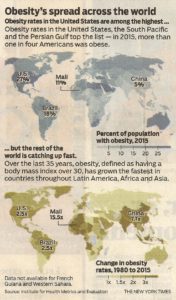The New York Times reports that over the past 35 years, Obesity has increased in the U.S. and Brazil by 2.5 times. It has grown fastest in the countries throughout Latin America, Africa and Asia.
Obesity has increased in China and Mali by 7.7 and 15.5 times respectively.
The shift to Western-style processed food and sugary drinks is contributing to a new epidemic of diabetes and heart disease, chronic illnesses that are fed by soaring rates of obesity in places that struggled with hunger and malnutrition just a generation ago.
 The U.S. has been too successful at countering the world’s hunger and malnutrition problem with cheap high-calorie food. Indeed, it might be said that one of the U.S.’s major exports is obesity.
The U.S. has been too successful at countering the world’s hunger and malnutrition problem with cheap high-calorie food. Indeed, it might be said that one of the U.S.’s major exports is obesity.
Classic advice for avoiding hyperglycemia and obesity is to eat healthy foods with vegetables, fruits, whole grains, and beans which are high in fiber. Include foods in your diet that are low in fat, such as low-fat dairy (milk, yogurt, and cheese), fish, and lean meat and limit foods that are high in calories and sugar, such as sweet desserts, potato chips, and candy. The latter comprises a signficiant portion of our exports.
Alas, a Western diet brings with it the health problems of the Western world.

 McKinsey Global Institute has projected that by 2030, 50% of the world’s population will be obese and the annual cost of Obesity-related disease expenditures will have risen to $17,000,000,000,000.
McKinsey Global Institute has projected that by 2030, 50% of the world’s population will be obese and the annual cost of Obesity-related disease expenditures will have risen to $17,000,000,000,000.